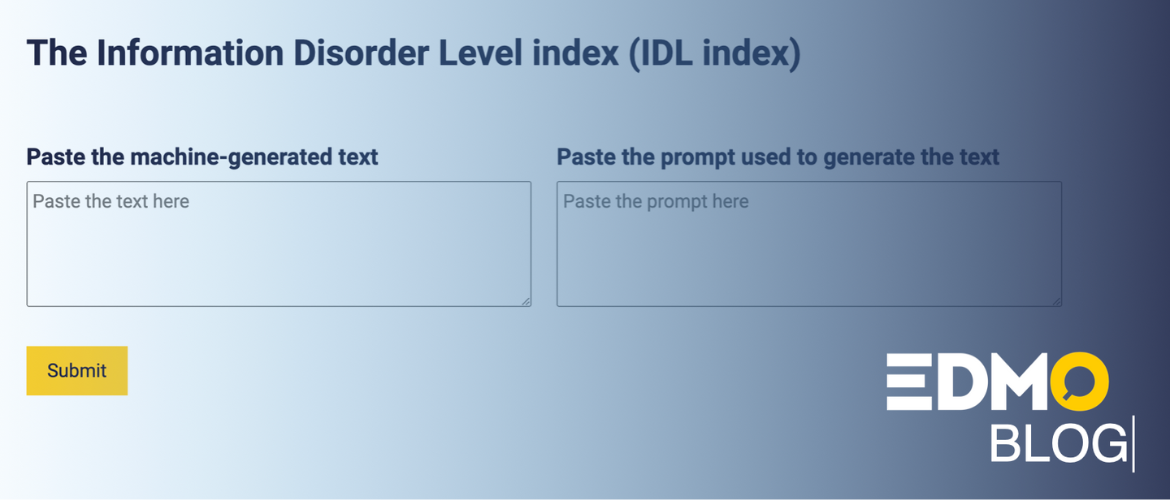The Information Disorder Level (IDL) Index: An experiment to assess machine-generated content’s factuality
Laurence Dierickx
Postdoc Researcher, University of Bergen (NORDIS hub)
Abstract:
Generative AI systems, such as ChatGPT, raise concerns about generating biased and misleading content that often deviates from real-world input. The Information Disorder Level (IDL), originally created to measure artificial hallucinations, is a valuable media literacy tool that promotes critical thinking about machine-generated content and its factual accuracy.
Key words: ChatGPT, generative AI, artificial hallucinations, media literacy
Six months after its launch, ChatGPT has reached one million active users. In the family of generative AI, it is a large language model that relies on a massive amount of textual data to generate content. But make no mistake: a generative AI does not understand what it produces, and it lacks consciousness or emotion in the human sense: it is “only” a mathematical process that combines logic, statistics and probability. Nevertheless, its accessibility – because it does not require programming skills – and its power have put it at the forefront of tools that can help journalists with a wide range of tasks: brainstorming, translation, text summarisation, data analysis or content production. ChatGPT has probably helped to accelerate the use of AI systems in journalistic workflows.
The flip side is that ChatGPT can also be used to produce manipulated content in a context where information disruption has become a major concern for democratic societies. Although the spread of fake news and propaganda online is not new, generative AI raises concerns due to its ability to quickly and at scale create misleading content that can easily be mistaken for content written by a human.
Research has already shown that such systems can easily create harmful and hateful texts. To add to this concern, research has also highlighted that large language models are likely to produce inaccurate news content or more convincing and trustworthy articles than those written by humans. Although these risks are well known, identifying and debunking such content remains a challenge, especially as disinformation is not always intentional. Large-scale language models such as ChatGPT are also known to produce “artificial hallucinations”, which consist of generating content that does not correspond to the real world.
We worked on this topic at the University of Bergen, which is part of the NORDIS hub. In a “fake news experiment” we asked ChatGPT to generate a corpus of 40 pieces based on fabricated and real events. During the generation process, we observed that despite clear instructions, ChatGPT generated additional fabricated things – regardless of whether the facts introduced in the prompts were true or false. For example, we asked ChatGPT to write about a car accident in Norway:
“Facts
Four people died
They were crossing the road
A car hurt them
Then a bus hit the car
911 was called
Rescuers can do nothing
It happened somewhere in Norway
Write a factual news article about it”.
The system generated a text that contained a lot of additional information, such as:
- “The incident has left the local community in a state of shock and mourning”.
- “Authorities have initiated a thorough investigation into the circumstances surrounding the accident”.
- “Eyewitnesses present at the scene reported a scene of chaos and confusion”, “The community in Norway is coming together to support one another during this difficult time”, “Our thoughts and prayers go out to the families and loved ones of the victims during this challenging period of grief and sorrow.”
Considering that human-based judgements are an interesting way to assess machine-generated content due to the lack of accuracy of online detectors, we have developed a tool to quantify the volume of invented statements and comments or opinions generated by the system. It consists of evaluating a generated text sentence by sentence. The system then calculates an Information Disorder Level (IDL) index ranging from 0 to 10. A text is considered reliable and accurate with a score of 0. In our experiment, only one text of our corpus of 40 generated contents reached this ideal score. The average score was 3.9 and the maximum score was 8.3. Also of concern is the level of comments or opinions introduced in the texts, with an average score of 51.7% and a maximum score of 94.1%.
The interface of the tool is currently available in English, but content can be rated in any language: http://idlindex.net. The next step will be to collect as many human ratings as possible to build a robust training dataset, with the aim to continue to experiment in this area. The tool, that also provides the possibility to reassess already assessed content, was presented at the 16th Dubrovnik Media Days in September, at the 5th Multidisciplinary International Symposium on Disinformation in Open Online Media (MISDOOM) in November, and at the Conference on Generative Methods in Copenhagen organised in December last year. The scientific paper explaining the experiment and the tool is available in open access: https://link.springer.com/chapter/10.1007/978-3-031-47896-3_5
At this research stage, we see two main takeaways from this experience: the need for post-editing machine-generated content to remove inaccurate content and considering the limitations of generative AI in broader digital media literacy programmes. The tool helps to understand the challenges associated with potential biases in training data and the unintentional spread of misinformation through artificial hallucinations. Doing so contributes to the ongoing efforts to mitigate the negative impact of generative AI on information quality by promoting critical thinking and developing safeguards against the unintended consequences of generative AI in the broader fight against disinformation.
